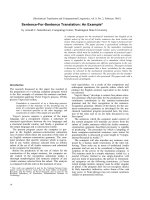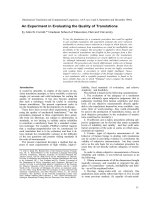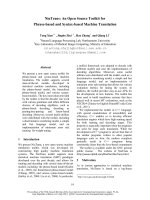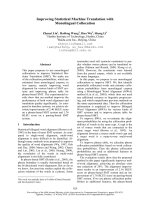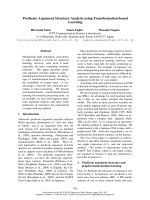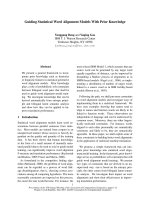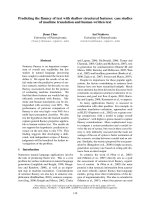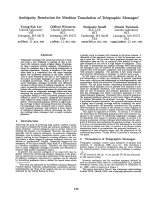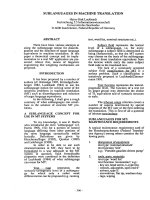Báo cáo khoa học: "An Interactive Machine Translation System with Online Learning" pdf
Bạn đang xem bản rút gọn của tài liệu. Xem và tải ngay bản đầy đủ của tài liệu tại đây (521.96 KB, 6 trang )
Proceedings of the ACL-HLT 2011 System Demonstrations, pages 68–73,
Portland, Oregon, USA, 21 June 2011.
c
2011 Association for Computational Linguistics
An Interactive Machine Translation System with Online Learning
Daniel Ortiz-Mart
´
ınez, Luis A. Leiva, Vicent Alabau,
Ismael Garc
´
ıa-Varea
†
, Francisco Casacuberta
ITI - Institut Tecnol
`
ogic d’Inform
`
atica, Universitat Polit
`
ecnica de Val
`
encia
† Departamento de Sistemas Inform
´
aticos, Universidad de Castilla-La Mancha
{dortiz,luileito,valabau,fcn}@iti.upv.es,
†
Abstract
State-of-the-art Machine Translation (MT)
systems are still far from being perfect. An
alternative is the so-called Interactive Ma-
chine Translation (IMT) framework, where
the knowledge of a human translator is com-
bined with the MT system. We present a sta-
tistical IMT system able to learn from user
feedback by means of the application of on-
line learning techniques. These techniques al-
low the MT system to update the parameters of
the underlying models in real time. According
to empirical results, our system outperforms
the results of conventional IMT systems. To
the best of our knowledge, this online learning
capability has never been provided by previ-
ous IMT systems. Our IMT system is imple-
mented in C++, JavaScript, and ActionScript;
and is publicly available on the Web.
1 Introduction
The research in the field of machine translation
(MT) aims to develop computer systems which are
able to translate text or speech without human in-
tervention. However, current translation technology
has not been able to deliver full automated high-
quality translations. Typical solutions to improve the
quality of the translations supplied by an MT system
require manual post-editing. This serial process pre-
vents the MT system from integrating the knowledge
of the human translator.
An alternative way to take advantage of the exist-
ing MT technologies is to use them in collaboration
with human translators within a computer-assisted
translation (CAT) or interactive framework (Isabelle
and Church, 1997). Interactivity in CAT has been
explored for a long time. Systems have been de-
signed to interact with linguists to solve ambiguities
or update user dictionaries.
An important contribution to CAT technology was
pioneered by the TransType project (Foster et al.,
1997; Langlais et al., 2002). The idea proposed in
that work was to embed data driven MT techniques
within the interactive translation environment. Fol-
lowing the TransType ideas, Barrachina et al. (2009)
proposed the so-called IMT framework, in which
fully-fledged statistical MT (SMT) systems are used
to produce full target sentences hypotheses, or por-
tions thereof, which can be accepted or amended
by a human translator. Each corrected text segment
is then used by the MT system as additional infor-
mation to achieve improved suggestions. Figure 1
shows an example of a typical IMT session.
The vast majority of the existing work on
IMT makes use of the well-known batch learning
paradigm. In the batch learning paradigm, the train-
ing of the IMT system and the interactive transla-
tion process are carried out in separate stages. This
paradigm is not able to take advantage of the new
knowledge produced by the user of the IMT system.
In this paper, we present an application of the online
learning paradigm to the IMT framework. In the on-
line learning paradigm, the training and prediction
stages are no longer separated. This feature is par-
ticularly useful in IMT since it allows to take into ac-
count the user feedback. Specifically, our proposed
IMT system can be extended with the new training
samples that are generated each time the user vali-
dates the translation of a given source sentence. The
online learning techniques implemented in our IMT
system incrementally update the statistical models
involved in the translation process.
2 Related work
There are some works on IMT in the literature that
try to take advantage of user feedback. One exam-
ple is the work by Nepveu et al. (2004), where dy-
namic adaptation of an IMT system via cache-based
model extensions to language and translation models
is proposed. One major drawback of such proposal
is its inability to learn new words.
68
source(f ): Para ver la lista de recursos
reference(
ˆ
e): To view a listing of resources
interaction-0
e
p
e
s
To view the resources list
interaction-1
e
p
To view
k a
e
s
list of resources
interaction-2
e
p
To view a list
k list i
e
s
list i ng resources
interaction-3
e
p
To view a listing
k o
e
s
o f resources
accept e
p
To view a listing of resources
Figure 1: IMT session to translate a Spanish sentence into English. In interaction-0, the system suggests a translation
(e
s
). In interaction-1, the user moves the mouse to accept the first eight characters “To view ” and presses the a key
(k), then the system suggests completing the sentence with “list of resources” (a new e
s
). Interactions 2 and 3 are
similar. In the final interaction, the user accepts the current suggestion.
Recent research on IMT has proposed the use of
online learning as one possible way to successfully
incorporate user feedback in IMT systems (Ortiz-
Mart
´
ınez et al., 2010). In the online learning setting,
models are trained sample by sample. For this rea-
son, such learning paradigm is appropriate for its use
in the IMT framework. The work by Ortiz-Mart
´
ınez
et al. (2010) implements online learning as incre-
mental learning. Specifically, an IMT system able
to incrementally update the parameters of all of the
different models involved in the interactive transla-
tion process is proposed. One previous attempt to
implement online learning in IMT is the work by
Cesa-Bianchi et al. (2008). In that work, the authors
present a very constrained version of online learn-
ing, which is not able to extend the translation mod-
els due to the high time cost of the learning process.
We have adopted the online learning techniques
proposed in (Ortiz-Mart
´
ınez et al., 2010) to imple-
ment our IMT system. We are not aware of other
IMT tools that include such functionality. For in-
stance, a prototype system for text prediction to help
translators is shown in (Foster et al., 2002). Addi-
tionally, Koehn (2009) presents the Caitra transla-
tion tool. Caitra aids linguists suggesting sentence
completions, alternative words or allowing users to
post-edit machine translation output. However, nei-
ther of these systems are able to take advantage of
the user validated translations.
3 Interactive Machine Translation
IMT can be seen as an evolution of the statistical ma-
chine translation (SMT) framework. In SMT, given
source string f , we seek for the target string e which
maximizes the posterior probability:
ˆ
e = argmax
e
P r(e|f ) (1)
Within the IMT framework, a state-of-the-art
SMT system is employed in the following way. For
a given source sentence, the SMT system automati-
cally generates an initial translation. A human trans-
lator checks this translation from left to right, cor-
recting the first error. The SMT system then pro-
poses a new extension, taking the correct prefix e
p
into account. These steps are repeated until the
whole input sentence has been correctly translated.
In the resulting decision rule, we maximize over all
possible extensions e
s
of e
p
:
ˆ
e
s
= argmax
e
s
P r(e
s
|e
p
, f ) (2)
It is worth to note that the user interactions are at
character level, that is, for each submitted keystroke
the system provides a new extension (or suffix) to
the current hypothesis. A typical IMT session for a
given source sentence is depicted in Figure 1.
State-of-the-art SMT systems follow a log-linear
approach (Och and Ney, 2002), where the posterior
69
probability P r(e | f ) of Eq. (1) is used. Such log-
linear approach can be easily adapted for its use in
the IMT framework as follows:
ˆ
e
s
= argmax
e
s
M
m=1
λ
m
h
m
(e
p
, e
s
, f )
(3)
where each h
m
(e
p
, e
s
, f ) is a feature function rep-
resenting a statistical model and λ
m
its correspond-
ing weight. Typically, a set of statistical generative
models are used as feature functions. Among this
feature functions, the most relevant are the language
and translation models. The language model is im-
plemented using statistical n-gram language mod-
els and the translation model is implemented using
phrase-based models.
The IMT system proposed here is based on a log-
linear SMT system which includes a total of seven
feature functions: an n-gram language model, a tar-
get sentence length model, inverse and direct phrase-
based models, source and target phrase length mod-
els and a reordering model.
4 Online Learning
In the online learning paradigm, learning proceeds
as a sequence of trials. In each trial, a sample is
presented to the learning algorithm to be classified.
Once the sample is classified, its correct label is told
to the learning algorithm.
The online learning paradigm fits nicely in the
IMT framework, since the interactive translation of
the source sentences generates new user-validated
training samples that can be used to extend the sta-
tistical models involved in the translation process.
One key aspect in online learning is the time re-
quired by the learning algorithm to process the new
training samples. One way to satisfy this constraint
is to obtain incrementally updateable versions of the
algorithms that are executed to train the statistical
models involved in the translation process. We have
adopted this approach to implement our IMT sys-
tem. Specifically, our proposed IMT system imple-
ments the set of training algorithms that are required
to incrementally update each component of the log-
linear model. Such log-linear model is composed of
seven components (see section 3). One key aspect of
the required training algorithms is the necessity to
replace the conventional expectation-maximization
(EM) algorithm by its incremental version (Neal and
Hinton, 1998). The complete details can be found in
(Ortiz-Mart
´
ınez et al., 2010).
5 System Overview
In this section the main features of our prototype are
shown, including prototype design, interaction pro-
tocol, prototype functionalities and demo usage.
5.1 Prototype Design
Prototype architecture has been built on two main
aspects, namely, accessibility and flexibility. The
former is necessary to reach a larger number of po-
tential users. The latter allows researchers to test
different techniques and interaction protocols.
For that reason, we developed an CAT Appli-
cation Programming Interface (API) between the
client and the actual translation engine, by using
a network communication protocol and exposing a
well-defined set of functions.
Figure 2: IMT system architecture.
A diagram of the architecture is shown in Fig-
ure 2. On the one hand, the IMT client provides a
User Interface (UI) which uses the API to commu-
nicate with the IMT server through the Web. The
hardware requirements in the client are very low,
as the translation process is carried out remotely on
the server, so virtually any computer (including net-
books, tablets or 3G mobile phones) should be fairly
enough. On the other hand, the server, which is
unaware of the implementation details of the IMT
client, uses and adapts the statistical models that are
used to perform the translation.
5.2 User Interaction Protocol
The protocol that rules the IMT process has the fol-
lowing steps:
1. The system proposes a full translation of the
selected text segment.
70
Figure 3: Demo interface. The source text segments are automatically extracted from source document. Such segments
are marked as pending (light blue), validated (dark green), partially translated (light green), and locked (light red). The
translation engine can work either at full-word or character level.
2. The user validates the longest prefix of the
translation which is error-free and/or corrects
the first error in the suffix. Corrections are
entered by amendment keystrokes or mouse
clicks/wheel operations.
3. In this way, a new extended consolidated pre-
fix is produced based on the previous validated
prefix and the interaction amendments. Using
this new prefix, the system suggests a suitable
continuation of it.
4. Steps 2 and 3 are iterated until the user-desired
translation is produced.
5. The system adapts the models to the new vali-
dated pair of sentences.
5.3 Prototype Functionality
The following is a list of the main features that the
prototype supports:
• When the user corrects the solution proposed
by the system, a new improved suffix is pre-
sented to the user.
• The system is able to learn from user-validated
translations.
• The user is able to perform actions by means
of keyboard shortcuts or mouse gestures. The
supported actions on the proposed suffix are:
Substitution Substitute the first word or char-
acter of the suffix.
Deletion Delete the first word of the suffix.
Insertion Insert a word before the suffix.
Rejection The rejected word will not appear in
the following proposals.
Acceptance Assume that the current transla-
tion is correct and adapt the models.
• At any time, the user is able to visualize the
original document (Figure 4(a)), as well as a
properly formated draft of the current transla-
tion (Figure 4(b)).
• Users can select the document to be translated
from a list or upload their own documents.
5.4 Demo Description and Usage
This demo exploits the WWW to enable the connec-
tion of simultaneous accesses across the globe, coor-
dinating client-side scripting with server-side tech-
nologies. The interface uses web technologies such
as XHTML, JavaScript, and ActionScript; while the
IMT engine is written in C++.
The prototype is publicly available on the Web
( To begin
with, the UI loads an index of all available transla-
tion corpora. Currently, the prototype can be tested
with the well-known Europarl corpora (Koehn,
2005). The user chooses a corpus and navigates to
the main interface page (Figure 3), where she in-
teractively translates the text segments one by one.
User’s feedback is then processed by the IMT server.
71
(a) Source document example, created from EuroParl corpus.
(b) Translated example document, preserving original format and highlighting non-translated sentences.
Figure 4: Translating documents with the proposed system.
All corrections are stored in plain text logs on the
server, so the user can retake them in any mo-
ment, also allowing collaborative translations be-
tween users. On the other hand, this prototype al-
lows uploading custom documents in text format.
Since the users operate within a web browser,
the system also provides crossplatform compatibil-
ity and requires neither computational power nor
disk space on the client’s machine. The communi-
cation between application and web server is based
on asynchronous HTTP connections, providing thus
a richer interactive experience (no page refreshes are
required.) Moreover, the Web server communicates
with the IMT engine through binary TCP sockets,
ensuring really fast response times.
6 Experimental Results
Experimental results were carried out using the Xe-
rox corpus (Barrachina et al., 2009), which con-
sists of translation of Xerox printer manual involv-
ing three different language pairs: French-English,
Spanish-English, and German-English. This corpus
has been extensively used in the literature to report
IMT results. The corpus consists of approximately
50,000 sentences pairs for training, 1,000 for devel-
opment, and 1,000 for test.
The evaluation criteria used in the experiments are
the key-stroke and mouse-action ratio (KSMR) met-
ric (Barrachina et al., 2009), which measures the
user effort required to generate error-free transla-
tions, and the well-known BLEU score, which con-
stitutes a measure of the translation quality.
The test corpora were interactively translated
from English to the other three languages, compar-
ing the performance of a batch IMT (baseline) and
the online IMT systems. The batch IMT system
is a conventional IMT system which is not able to
take advantage of user feedback after each trans-
lation is performed. The online IMT system uses
the translations validated by the user to adapt the
translation models at runtime. Both systems were
initialized with a log-linear model trained in batch
mode using the training corpus. Table 1 shows the
BLEU score and the KSMR for the batch and the
online IMT systems (95% confidence intervals are
shown). The BLEU score was calculated from the
first translation hypothesis produced by the IMT sys-
tem for each source sentence. All the obtained im-
provements with the online IMT system were statis-
tically significant. The average online training time
for each new sample presented to the system, and
the average response time for each user interaction
72
(that is, time that the system uses to propose new
extensions for corrected prefixes) are also shown in
Table 1, which are less than a tenth of a second and
around two tenths of a second respectively
1
. Ac-
cording to the reported response and online training
times, we can argue that the system proposed here is
able to be used on real time scenarios.
System BLEU KSMR LT/RT (s)
En-Sp
batch 55.1± 2.3 18.2± 1.1 – /0.09
online 60.6± 2.3 15.8± 1.0 0.04 /0.09
En-Fr
batch 33.7± 2.0 33.9± 1.3 – /0.14
online 42.2± 2.2 27.9± 1.3 0.09 /0.14
En-Ge
batch 20.4± 1.8 40.3± 1.2 – /0.15
online 28.0± 2.0 35.0± 1.3 0.07 /0.15
Table 1: BLEU and KSMR results for the XEROX test
corpora using the batch and the online IMT systems, re-
porting the average online learning (LT) and the interac-
tion response times (RP) in seconds.
It is worth mentioning that the results presented
here significantly improve those presented in (Bar-
rachina et al., 2009) for other state-of-the-art IMT
systems using the same corpora.
7 Conclusions
We have described an IMT system with online learn-
ing which is able to learn from user feedback in real
time. As far as we know, to our knowledge, this
feature have never been provided by previously pre-
sented IMT prototypes.
The proposed IMT tool is publicly available
through the Web ( />imt/). Currently, the system can be used to inter-
actively translate the well-known Europarl corpus.
We have also carried out experiments with simulated
users. According to such experiments, our IMT
system is able to outperform the results obtained
by conventional IMT systems implementing batch
learning. Future work includes researching further
on the benefits provided by our online learning tech-
niques with experiments involving real users.
Acknowledgments
Work supported by the EC (FEDER/FSE), the Span-
ish Government (MEC, MICINN, MITyC, MAEC,
1
All the experiments were executed in a PC with 2.40 GHz
Intel Xeon processor and 1GB of memory.
“Plan E”, under grants MIPRCV “Consolider In-
genio 2010” CSD2007-00018, iTrans2 TIN2009-
14511, erudito.com TSI-020110-2009-439), the
Generalitat Valenciana (grant Prometeo/2009/014,
grant GV/2010/067), the Universitat Polit
`
ecnica de
Val
`
encia (grant 20091027), and the Spanish JCCM
(grant PBI08-0210-7127).
References
S. Barrachina, O. Bender, F. Casacuberta, J. Civera,
E. Cubel, S. Khadivi, A. Lagarda, H. Ney, J. Tom
´
as,
and E. Vidal. 2009. Statistical approaches to
computer-assisted translation. Computational Lin-
guistics, 35(1):3–28.
N. Cesa-Bianchi, G. Reverberi, and S. Szedmak. 2008.
Online learning algorithms for computer-assisted
translation. Deliverable D4.2, SMART: Stat. Multi-
lingual Analysis for Retrieval and Translation.
G. Foster, P. Isabelle, and P. Plamondon. 1997. Target-
text mediated interactive machine translation. Ma-
chine Translation, 12(1):175–194.
G. Foster, P. Langlais, and G. Lapalme. 2002. Transtype:
text prediction for translators. In Proc. HLT, pages
372–374.
P. Isabelle and K. Church. 1997. Special issue on
new tools for human translators. Machine Translation,
12(1–2).
P. Koehn. 2005. Europarl: A parallel corpus for statisti-
cal machine translation. In Proc. of the MT Summit X,
pages 79–86, September.
P. Koehn. 2009. A web-based interactive computer aided
translation tool. In Proc. ACL-IJCNLP, ACLDemos,
pages 17–20.
P. Langlais, G. Lapalme, and M. Loranger. 2002.
Transtype: Development-evaluation cycles to boost
translator’s productivity. Machine Translation,
15(4):77–98.
R.M. Neal and G.E. Hinton. 1998. A view of the
EM algorithm that justifies incremental, sparse, and
other variants. In Proc. of the NATO-ASI on Learning
in graphical models, pages 355–368, Norwell, MA,
USA.
L. Nepveu, G. Lapalme, P. Langlais, and G. Foster. 2004.
Adaptive language and translation models for interac-
tive machine translation. In Proc. EMNLP, pages 190–
197.
F. J. Och and H. Ney. 2002. Discriminative Training
and Maximum Entropy Models for Statistical Machine
Translation. In Proc. ACL, pages 295–302.
D. Ortiz-Mart
´
ınez, I. Garc
´
ıa-Varea, and F. Casacuberta.
2010. Online learning for interactive statistical ma-
chine translation. In Proc. NAACL/HLT, pages 546–
554.
73
